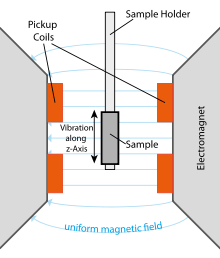Vibrating-sample magnetometer
A vibrating-sample magnetometer (VSM) (also referred to as a Foner magnetometer) is a scientific instrument that measures magnetic properties. Simon Foner at MIT Lincoln Laboratory invented VSM in 1955 and reported it in 1959.[1] Also it was mentioned by G.W. Van Oosterhout[2] and by P.J Flanders[3] in 1956. A sample is first magnetized in a uniform magnetic field. It is then sinusoidally vibrated, typically through the use of a piezoelectric material. Commercial systems use linear actuators of some form. Historically, these systems were developed using modified audio speakers, though this approach was dropped due to the interference through the produced in-phase magnetic noise, as the magnetic flux through a nearby pickup coil varies sinusoidally. The induced voltage in the pickup coil is proportional to the sample's magnetic moment, but does not depend on the strength of the applied magnetic field. In a typical setup, the induced voltage is measured with a lock-in amplifier using the piezoelectric signal as a frequency reference. It is also possible to record the hysteresis curve of a material by sweeping the magnetic field.

.jpg)
The idea of vibrating sample came from D. O. Smith's[4] vibrating-coil magnetometer.
References
- Foner, Simon (1959). "Versatile and Sensitive Vibrating-Sample Magnetometer". Rev. Sci. Instrum. 30 (7): 548–557. Bibcode:1959RScI...30..548F. doi:10.1063/1.1716679.
- Van Oosterhout, G.W. (1956). Appl. Sci. Res. B6: 101. Missing or empty
|title=(help) - Flanders, P.J. (1956). IEEE Special Publication, Conference on Magnetism and Magnetic Materials. T-91: 315–317. Missing or empty
|title=(help) - Smith, D. O. (1956). "Development of a Vibrating‐Coil Magnetometer". Rev. Sci. Instrum. 27 (261): 261. Bibcode:1956RScI...27..261S. doi:10.1063/1.1715538.